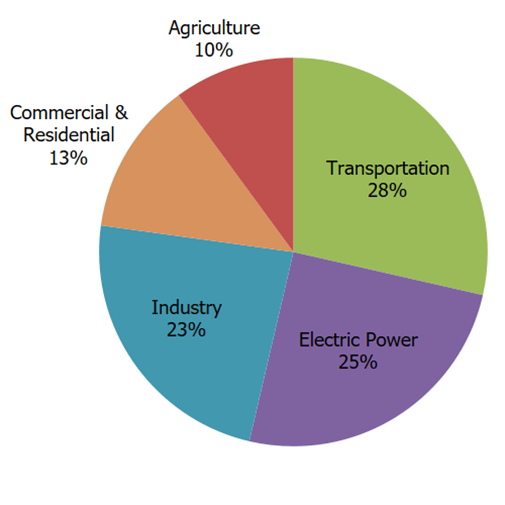What Are Emissions?
Since the industrial revolution, human population growth, deforestation, industry, and advancements in technology – like in-home electricity and cars – have caused an increase in the concentration of greenhouse gases (GHGs) in Earth’s atmosphere.
Many of these inventions and technologies require energy, which is often produced by fossil fuels — like coal, oil, and natural gas. Burning fossil fuels releases carbon dioxide and other greenhouse gases into the atmosphere. We call the release of these gases from burning fossil fuels and other activities emissions.
The Greenhouse Effect
When light from the sun passes through the atmosphere, some of its heat is trapped by certain gases like carbon dioxide and methane. These are called greenhouse gases because of the effect they have on the Earth’s temperature, which is similar to that of a greenhouse. The greenhouse effect is a natural process that makes the planet warm.
Plants, soils, and the ocean can absorb some carbon dioxide, but they can’t keep up with all greenhouse gas emissions. Those extra greenhouse gases get stuck in our atmosphere for a long time, from hundreds to even thousands of years. The more greenhouse gas molecules that we have in the atmosphere, the warmer the atmosphere gets.
Effects on Health
Emissions don’t just contribute to the greenhouse effect – they can also impact our health. Certain gases and particles that are released by both natural processes and human activities are considered air pollutants.
Many people experience symptoms such as watery eyes, coughing or wheezing when air pollution concentration levels are high. Polluted air can cause respiratory irritation or breathing difficulties during exercise or outdoor activities; the health effects of air pollution can be even worse for children under age 14, pregnant people, athletes or outdoor workers, and individuals with existing heart or lung conditions.
Reducing emissions from human activities can reduce air pollution, creating a healthier environment for everyone.
Emissions Sources
The majority of greenhouse gas emissions in the U.S. are a product of transportation and electric power production. The greenhouse gases produced in these two industries primarily come from burning fossil fuels like coal, petroleum products, and natural gas. Carbon dioxide is the main greenhouse gas emission from the transportation and electric power production sectors, although small amounts of methane and nitrous oxide are also produced.
Industrial, commercial, and residential sectors also burn fossil fuels, and are responsible for the emission of less common greenhouse gases, like perfluorocarbons (PFCs), hydrofluorocarbons (HFCs), and sulfur hexafluoride, that may be products from chemical reactions or leaking equipment.
Finally, activities from the agricultural sector can emit nitrous oxide, methane, and some carbon dioxide. These emissions come from various soil and fertilizer management practices as well as raising livestock.

PCAP Measures
Transportation-sector emissions can be reduced using measures that cut the amount of fossil fuels needed for everyday travel. The measures selected in the Knoxville MSA's PCAP include expanding electric vehicle infrastructure, expanding and improving public transit, transitioning to electric and alternative-fuel vehicles in public fleets, and boosting active transportation and the use of alternative transportation systems.
Measures that were selected to reduce building and electric power emissions include amplifying opportunities for and development of building efficiency upgrades, developing and investing in renewables, and developing and implementing strategies to electrify buildings.
Other sectors - such as waste, agriculture, and land use – and other measures (such as tree canopy) are lower-impact and require more research/data calculations and are therefore a better fit for the CCAP.
